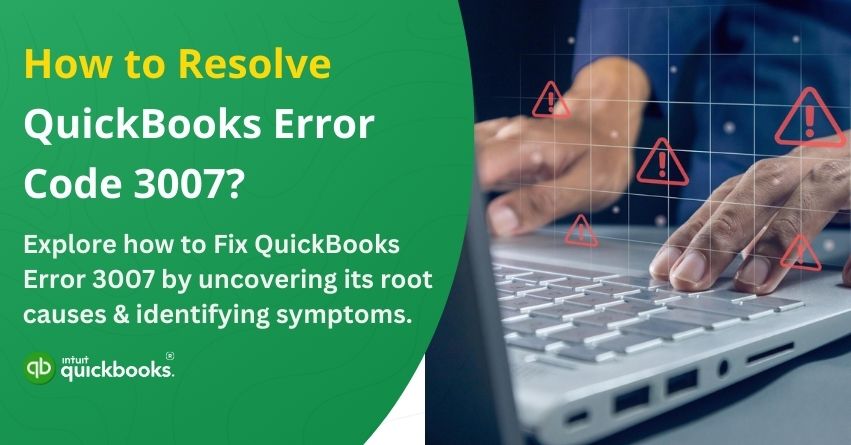QuickBooks Point of Sale (POS) is a prominent solution for many businesses, helping streamline sales and inventory management. However, like any software, users may encounter occasional errors that can disrupt their workflow. One such issue is QuickBooks POS Error 3007, which typically occurs when trying to validate data within the software. QuickBooks Error 3007 can lead to failure of the verification process, potentially affecting your financial data integrity. QuickBooks Error 3007 generally appears when the software is unable to complete its data verification process successfully. This verification process is a built-in security measure in QuickBooks designed to check and maintain the accuracy and integrity of your financial records.
In this blog, we will highlight the solutions to fix or troubleshoot error 3007 in QuickBooks POS but before that, let’s explore the causes and symptoms of the same. So, let’s get started!
What Triggers QuickBooks POS Error 3007?
QuickBooks POS Error Code 3007 is often linked to problems within the software environment or network setup that prevent the system from successfully running its internal data verification process. This error can disrupt your ability to process transactions or access company data efficiently. Here are some of the common causes behind this issue:
1. Damaged or Corrupted QuickBooks Company File
When your company file becomes corrupted or damaged, QuickBooks may struggle to verify the integrity of the data. This typically happens due to improper shutdowns, system crashes, or malware infections. As a result, the software may display Error 3007 during its verification process, alerting you to potential inconsistencies or unreadable data within the file.
2. Firewall or Antivirus Interference
Security software like firewalls or antivirus programs can sometimes block essential QuickBooks components from running correctly. If these programs mistakenly identify QuickBooks operations as a threat, they may prevent the software from executing its data verification or connecting with necessary services, triggering error messages such as Error 3007.
3. Network Connectivity Issues in Multi-User Setups
In multi-user environments, QuickBooks POS relies on stable network communication between workstations and the server. Any disruptions—like dropped connections, misconfigured network settings, or limited permissions—can interfere with the verification process, especially if the company file is stored on another machine. This often results in errors during routine tasks.
4. Outdated QuickBooks Versions
Using an outdated version of QuickBooks POS can lead to compatibility issues and bugs that interfere with core functions such as data verification. Older versions may lack necessary patches or updates required to handle newer data structures or interact with updated operating systems, resulting in errors like 3007.
5. Incomplete or Faulty QuickBooks Installation
If the QuickBooks POS installation was interrupted, incomplete, or corrupted, some critical files or services may be missing or broken. This can cause essential features like the verification tool to malfunction, leading to runtime errors including 3007. Reinstalling the software often resolves this issue by replacing any missing or damaged components.
So, these are some of the causes that trigger QuickBooks error 3007. Now, let’s take a look at the symptoms that can help you detect the threat of this error.
Early Signs to Detect QuickBooks Error 3007 Effectively
Here are 5 early indications that can help users detect QuickBooks Error 3007 before it escalates into a bigger issue:
1. Verification Process Failure
When running the Verify Data utility, QuickBooks may suddenly stop the process or display an incomplete verification result without specifying the reason. This can be an early sign that something is wrong—possibly pointing toward Error 3007.
2. QuickBooks Freezes During Normal Use
If QuickBooks begins to freeze or lag unexpectedly, especially during tasks like accessing company files or generating reports, it might indicate underlying issues with the software’s ability to verify or access data—often a precursor to error 3007.
3. Interruption During Backup or Restore
Users may notice frequent interruptions or failures while backing up or restoring company files, which could suggest corrupted data or system files that the verification tool is unable to process properly.
4. Error Logs Showing Verification Failures
Checking QuickBooks logs (QBWin.log) may reveal verification-related errors or warning messages. If you see entries related to verification issues or integrity failures, it’s a strong early warning sign of Error 3007.
5. Outdated or Missing Digital Signature Alerts
If you receive prompts or security warnings related to a missing or expired digital signature certificate, QuickBooks might not be able to authenticate certain processes—leading to verification errors like 3007.
So, these are the five most common early signs that can help you detect the possible threat of QuickBooks error 3007. Now that we’ve covered causes and symptoms, let’s take a look at the solutions to troubleshoot it effectively.
5 Solutions to Remove POS Error 3007 in QuickBooks
Discover effective methods to fix and prevent QuickBooks POS Error 3007, ensuring smooth operation of your system.
Solution 1: Run QuickBooks File Doctor
QuickBooks File Doctor can repair common issues like Error 3007 or 3008 by fixing company files and network problems. Follow the given below steps:
Step 1: Download and Install QuickBooks Tool Hub
- Close QuickBooks before starting.
- Download and install the latest QuickBooks Tool Hub (version 1.6.0.5) from Intuit’s website and save it to a location like your Downloads folder or desktop.
- Open the downloaded file (QuickBooksToolHub.exe) and follow the installation instructions.
- After installation, double-click the Tool Hub icon on your desktop to launch it or search for it in Windows.
Step 2: Run Quick Fix My File
- In the Tool Hub, navigate to the Company File Issues Tab
- Click Quick Fix My File to eliminate minor file problems
- Once completed, click OK and restart your System or QuickBooks
Step 3: Run QuickBooks File Doctor
- In the Tool Hub, go back to the Company File Issues tab and select Run QuickBooks File Doctor.
- Wait for it to open; if it doesn’t, search for “QuickBooks Desktop File Doctor” and open it manually.
- In File Doctor, choose your company file from the dropdown or click Browse to locate it.
- Select Check Your File (middle option) and click Continue.
- Enter your QuickBooks admin password when prompted, then click Next.
Solution 2: Update the Windows Operating System
To resolve QuickBooks Error 307, follow the steps to update your Windows OS:
- Press the Windows key to open the Start menu.
- Click on Settings.
- Select Update & Security.
- Choose Windows Update to install the latest updates.
- Restart your system once the updates are installed.
Solution 3: Verify and Rebuild Data in QuickBooks
QuickBooks offers two essential tools—Verify and Rebuild Data—designed to help maintain the integrity of your company data file by detecting and resolving any issues.
Step 1: Verify Your Company Data
The Verify tool scans for common data issues in your company file:
- Close all open windows in QuickBooks by selecting Window > Close All.
- Navigate to File > Utilities > Verify Data.
- Based on the results, you’ll see:
- No Issues Detected: Your data is fine, and no further action is needed.
- Error Message: Search for the error on the QuickBooks Desktop support site for resolution.
- Data Damage Detected: If issues are found, you will need to rebuild your data.
Note: If you use Assisted Payroll, contact QuickBooks support before rebuilding your data.
Step 2: Rebuild Your Company Data
To fix issues found in your company file, follow these steps:
- Go to File > Utilities > Rebuild Data.
- QuickBooks will prompt you to create a backup. Click OK.
- Choose a location to save the backup, assign a unique file name, and click Save.
- Once rebuild completes, click OK.
- Finally, verify the data again by going to File > Utilities > Verify Data.
- If no further damage is found, you’re all settled!
If issues persist, check the QuickBooks support site using the qbwin.log for specific error messages. You may also consider restoring it from a recent backup if needed. Always keep in mind to keep recent backups to avoid re-entering data when restoring a company file.
Solution 4: Update QuickBooks Desktop Program
Follow the given steps below to Update QuickBooks Desktop and resolve POS Error 3007.
- Make sure QuickBooks is closed.
- Open the Windows Start menu, type QuickBooks Desktop, and press Enter.
- Right-click the QuickBooks icon and select Run as Admin.
- In the No Company Open window, go to the Help tab and select Update QuickBooks Desktop.
- Click Mark All in the Options tab, then Save.
- Select Reset Update, then click Get Updates.
- After downloading, close and reopen QuickBooks, and click Yes to install the updates. Restart your computer.
Solution 5: Get a Digital Signature Certificate
The verification process may fail to complete if a digital signature certificate is not installed for QuickBooks Desktop. Additionally, if the existing certificate has expired, it can lead to QuickBooks error code 3007.
- Navigate to the C:\Program Files\Intuit\QuickBooks directory on your computer.
- Locate the QBW32.exe file, right-click on it, and select Properties from the context menu.
- In the Properties window, go to the Digital Signatures tab and ensure that Intuit is selected from the list of signatures.
- Click on Details to proceed.
- In the Digital Signature Details window, choose the View Certificate option.
- Once the Certificate window opens, click on Install Certificate to begin the installation.
- Click Next, and then select Finish when prompted.
- To complete the process, restart your computer and then relaunch QuickBooks to check if the error has been resolved.
Solution 6: Restore a Backup Company File
The QBWIN.log file records details from tools like Verify, Rebuild, and Condense Data, helping identify issues within the QuickBooks Desktop company file. If errors are found in this log, restoring a backup (.qbb) is recommended. This allows QuickBooks to create a new, error-free company file (.qbw) to resolve issues like Error 3007.
Note: If your backup is on a USB or cloud service like Box, first move it to your local drive before proceeding.
- Open QuickBooks Desktop, go to the File menu, and select Open or Restore Company.
- Choose Restore a backup copy and click Next.
- Select Local Backup and click Next again.
- Locate your backup file, which will have a .qbb extension (e.g., YourCompany.qbb), by browsing your system.
- Choose a destination folder where the restored file will be saved.
- Click Open, then hit Save when you’re ready.
- If prompted about overwriting existing data, only proceed if you’re sure—never overwrite unintentionally.
- QuickBooks will now create a new, error-free company file for you to use.
So, these are the six most common and effective solutions to troubleshoot and eliminate QuickBooks POS Error 3007 once and for all.
Conclusion
QuickBooks POS Error 3007 can be a roadblock to seamless accounting and sales management, especially when it disrupts essential processes like data verification. However, with the right troubleshooting steps—from updating your software and system to verifying data integrity and restoring backups—you can resolve this error and minimize data-related risks. Regular backups, timely updates, and maintaining a secure software environment are key to avoiding such issues in the future. If you’re still facing problems even after trying all these solutions, don’t hesitate to reach out to our QuickBooks POS support for further assistance.
Frequently Asked Questions
QuickBooks Error 3007 is a verification failure error that appears when QuickBooks is unable to complete its internal data verification process. It typically occurs due to corrupted company files, outdated software, or missing digital signatures.
You may notice verification failure messages, freezing during file operations, or entries in the QBWin.log file indicating data issues. These are early signs that your company file might be affected.
Yes, updating QuickBooks to the latest version can often resolve compatibility or integrity issues that trigger error 3007.
Yes, the Rebuild Data tool is a built-in utility that safely repairs minor corruption in your company file. However, always create a backup before performing a rebuild.


